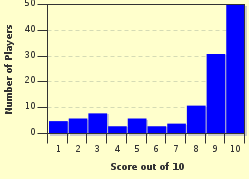Quiz Answer Key and Fun Facts
1. Mathematics is an extremely interesting field of endeavour and helps explain not just arithmetical phenomena, but, the meaning and structure behind the universe. Indices are important in how we can write, in shorthand, very long numbers or very small numbers. The symbol (^) is commonly used to indicate that the previous quantity (base) is being raised to the power of the succeeding quantity (exponent). Ergo, what would happen to a number if it is raised to the power 2? (5^2)
2. To what power has 4 been raised to attain the result of 256?
3. Index notation doesn't necessarily have to be in integers (whole numbers) or even positive for that matter. They can be both fractional and negative. What happens to the quantity being raised to a certain power if the index notation is negative?
4. When a quantity is raised to a fractional power, it undergoes two mathematical stages of change. The change is controlled by the denominator and numerator of the fraction. What mathematical function is controlled by the denominator of the fraction in the following example: 25^(3/2)?
5. What would be the exponent of the base 729 if you wanted to attain the result of 9?
6. Exponential indices are important when it comes to algebra. There is a whole set of rules which apply to algebraic index notation and can get a little complicated at times. For example, if you saw the following, what would you do to the indices: a^4 x a^2?
7. When working with exponents, numbers and letters are sometimes combined to form an alpha-numeric base. What is the results of the following: [5(a^3)]^2?
8. When faced with rooting algebraic expressions, the method of finding the solution can seem rather obscure but it can be logically attained. What is the solution to the following expression (*sqrt = square root): *sqrt([a^8][b^12][c^6])? [a, b and c are all positive integers]
9. Some indices are present even without notation. Similarly, the integer 10 can be written as 10/1, however, as it makes no difference to the integer it is rendered redundant and subsequently omitted. Which of the following powers would be redundant when trying to raise the base?
10. One particular notation that catches many people out is when a base is raised to the power of 0. If we assume a base of x (where x is NOT equal to 0), what will the result of x^0 be?
Source: Author
jonnowales
This quiz was reviewed by FunTrivia editor
crisw before going online.
Any errors found in FunTrivia content are routinely corrected through our feedback system.


